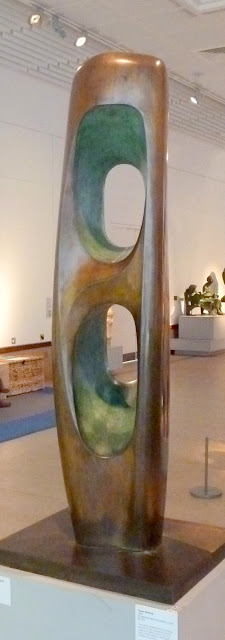Herbert Art Gallery in Coventry.
The history of the area on these panels outside the gallery.
Some of the artworks in the Herbert's permanent collection:
Bus Trip from the Pits, Margaret Green, 1956
A view of the beach at Seaton Carew near Hartlepool. Green was painting there when a coach arrived and the people poured onto the beach. They were from the mining towns of County Durham dressed in their Sunday best.
Bennett's Corner, Alan Lowndes, 1956
A typical working class street in Stockport by an artist who depicted the daily lives of working class communities in the 1950s and 1960s.
Woman with Shopping Bag, Cliff Rowe, before 1960
Cliff Rowe was a socialist whose work represented his concern for working life and industry. He lived in the Soviet Union for 18 months in the 1930s carrying out design commissions for the Red Army. Back in England he helped to found the Artists' International Foundation in 1933. This group saw art as a weapon in the class struggle and aimed to promote peace and oppose fascism. Woman with Shopping Bag is painted in the style of Soviet Socialist art.
The Fishmonger, Kenneth Long, 1956
Long painted everyday people and scenes in an industrial landscape. This work is realistic but there is a hint of abstraction in the emphasis on diamond shapes which produce a connection between the man and the fish.
Victoria, Lisa Gunn, 2003 (liquid light and acrylic on canvas)
Gunn was partially paralysed in a road accident in 1997. Here she photographed herself with her wheelchair. She refers to Man Ray who photographed a naked woman from the back so that she seemed to have no arms (Le Violon D'Ingres). She plays on ideas of a link between eroticism and disability. She alters her photographs with acid or paint to create a more complex image.
The Bridge, John Tunnard, 1964 (oil on board)
1946-47 Two Forms, Ben Nicholson, (oil and pencil on canvas)
This work is both an abstract painting and a still life. It can be seen as a glass on a table. Nicholson is concerned with the balance between two sets of shapes. The lines of the glass on the right balance an equal area of coloured shapes on the left.
Construction 5, Philip Wetton, 1966 (mixed media)
This is a piece of Op-Art which is made to create optical effects for the viewer. When you move in front of the piece the circles appear to dance in front of your eyes. This is because there are two sets of circles: one set is printed onto a white surface area while the other is printed onto a sheet of clear plastic just in front of you. The two sets are the same design but together they make disturbing patterns.
Colin Middleton, Sea Wall, 1966 (oil on board)
In this picture the architecture of the sea wall is reduced to a mosaic of interlocking rectangular shapes. The limited colour range and the repeating patterns unify the picture into one decorative scheme. The bird on the flagpole is used to define the location and the scale of the picture.
The Stackyard, Paul Nash, 1925 (oil on canvas)
Coventry Sculpture, Peter Lazlo Peri, 1959 (mixed media)
Figure (Walnut), Barbara Hepworth, 1964 (bronze)
The work is subtitled Walnut because the bronze was cast from a carving made out of walnut wood. The holes, an integral part of the sculpture, show that the interior space is as important as the solid part.
The Fount, Mark Dobson, 1948 (bronze)
Stretching Girl, Betty Read, 1963 (fibreglass)
Rea was associated with the Artists' International Association in the 1930s, which opposed imperialism, colonialism and fascism through art.
Bowl, Lucie Rie, before 1963.













Nice photos. Is that Herbert himself in the first photo?
ReplyDeleteHahaha!
Delete